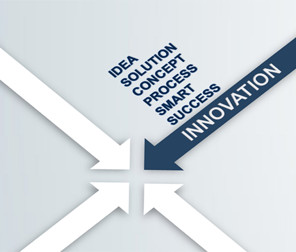
Internal vs. External Business Innovation: A Fork in the Road?
Internal and external innovation: two buzz words continually heard in business today, regardless of the industry you’re in. The buzz represents the significance these two concepts hold when it comes to business, but when it comes to implementing change within your organization it can be somewhat difficult to know where to start.
So, what do these two concepts mean?
Internal Innovation: simply put, this means change within your organization. This might be small or large change, something structural within a team, a change in the production process to increase efficiency, or something financial regarding your budget. This internal change, however, is done primarily within the organization, although the impacts may be visible both within the organization and outside of it.
External Innovation: in contrast to internal innovation, this means improvement to a product or service, for example, which directly impacts the customer. This may mean introducing new systems of service, or the implementation of a new product line to better meet your customers’ ever-evolving needs.
To Fuel the Innovation Engine, You Need to Identify the Inputs
The reality is: just because you want a specific result, doesn’t mean you’ll get it.
Measuring innovation also involves setting specific goals around ways of fueling innovation – things you do internally to help you hit your targets.
Lots of companies have calculated means of creating cultures of innovation.
- They put in place measures that explicitly promote certain behaviors.
- They shape their environments, so people have enough time, resources, and focus.
- They turn the creative process into real value creation.
Measuring the inputs of innovation gets real results.
Which Type of Business Innovation Costs More?
When it comes right down to overall costs, there is simply no way if determining whether one will bring more ROI than the other. Internal innovation is often cheaper, and usually easier. This is largely because internal innovation does not require the legwork that external innovation does.
With external innovation, research, development, copyrights, etc., all cost more, and require significant effort – but again, the result can also be significant.
When it comes to ROI, internal innovation tends to represent significant cost savings, as opposed to the increase in revenue brought about by external innovation. Increased efficiency or improved processes can mean substantial reductions in overall output.
In contrast, although external innovation often requires greater investment of resources, and therefore can represent a decreased ROI short term, the long-term impacts are usually more widely visible, both internally and externally.
Recognizing the ROI benefits, can your organization survive an entirely one directional strategic innovation strategy?
A prudent business innovation strategy is one that:
- Considers all the opportunities for change.
- Weighs all the resources required to make that change.
- Takes into consideration the company’s overall strategic plan.
These factors ensure that a balanced approach to innovation is maintained.
Business innovation, like internal and external innovation, is not a new concept – nor is it one that can be ignored if growth and expansion are desired. To stay relevant, you need to adapt. Improving your internal processes and continually improving your company’s offerings is the best way to achieve this.
Innovators Alliance is a peer-to-peer networking group of CEOs committed to driving business growth through innovation. Join us for an upcoming event to see what it’s all about!
Is your company innovative? Try our Innovation Assessment. It only takes 5 minutes!
Like this? You might also like:
- Cultures that Inspire!
- How to Get the Most from Your Business Networking Group
- 5 Ways Networking with Other CEOs Can Elevate Your Business
- Are you BIG in your organization? The Big Idea Guru! - December 10, 2014
- Get Out! Innovators Alliance at SNOLab Part 2 - December 3, 2014
- A Break for Adventure: Innovators Alliance at SNOLab Part 1 - November 26, 2014
